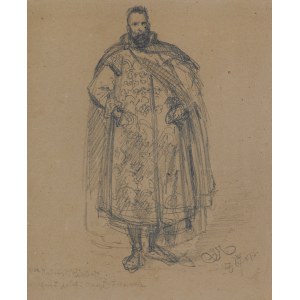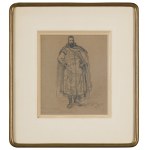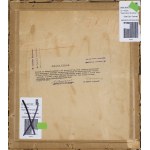21 x 17.5 cm (in light passe-partout)
signed p.d.: JM. | 1867 r.p. [tied monogram].
l.d.: Xiążę Radziwiłł Rudobrody | Polish magnate Bator times.
On the reverse, on a cardboard so-called "clasp" a certificate of authenticity issued by Dr. Kazimierz Buczkowski and Dr. Edward Łepkowski in October 1950;
in addition, two stickers of an auction house in Warsaw.
Mikolaj Radziwill "Rudy" (1512-1584) was the son of the Castellan of Vilnius, Great Hetman of Lithuania Jerzy Radziwill. An outstanding military commander, guardian of Barbara Radziwillowna (the second wife of King Sigismund Augustus), he was a staunch opponent of Lithuania's union with Poland.
The affair and subsequent clandestine marriage of his sister Barbara to monarch Sigismund Augustus significantly strengthened the Radziwill family's position in the Grand Duchy of Lithuania, elevating them above the other families. This imbalance was met with general indignation among the magnates, but it contributed to raising the position of Lithuania and restoring Vilnius as a viable capital. After Barbara's heirless death, King Sigismund Augustus, wishing to ensure the continuity of the union between Poland and Lithuania - against the objections of Mikolaj "the Red", who sought to maintain Lithuania's relative independence from the Crown - led to the signing of the Union of Lublin (1569). Mikolaj Radziwill was one of the few Lithuanian senators who were not signatories to the concluded agreement.
In 1565 Nikolai "Rudy" became chancellor and voivode of Vilnius, and held the office of hetman several times. His military career, which lasted almost 30 years, resulted in successes for the Lithuanian army, including a magnificent victory achieved during the Seven Years' War over the troops of Ivan IV the Terrible at the Battle of Tschaśniki.
Stefan Batory also placed his trust in Nicholas "Rudy", and the latter became his faithful ally. As hetman of the second elected king of the Polish-Lithuanian Commonwealth, he smashed the Russian forces at Kiesia, and during the subsequent campaigns of the Polish-Moscow war he captured Polotsk and Great Luki.
In 1581, despite his advanced age, he took part alongside the monarch in the Veliko-Luga campaign and the siege of Pskov. Having led the Radziwill family to rise to prominence and make it the most important magnate house in Lithuania, he ended his military career.
Jan Matejko (Krakow 1838 - Krakow 1893) - the most prominent Polish historical painter; he began his painting studies under W. Łuszczkiewicz and W. K. Stattler at the Krakow School of Fine Arts (1852-1858). He then studied at the Munich Academy under H. Anschütz (1859) and for two months at the Vienna Academy under C. Ruben (1860). After his studies he lived and worked in Cracow. In 1873 he took over as director of the School of Fine Arts there, holding this position until his death. He traveled extensively - he made numerous trips to Paris (in 1865-1880), Vienna (1866-1888), in 1872 he was in Constantinople, and a year later in Prague and Budapest, he also visited Italy (1878-1879 and 1883). He was a member of numerous academies and art societies, including the Académie des Beaux-Arts (1873) and the French Institute (1874) in Paris, the Berlin Academy of Art (1874), the Raphael Academy in Urbino (1878) and the Künstlersgenossenschaft in Vienna (1888). He became a member of the Scientific Society of Cracow in 1864, and received an honorary doctorate of philosophy from Jagiellonian University in 1887. He was the creator of great and well-known canvases, including the Sermon of Skarga, Rejtan, the Union of Lublin, Batory at Pskov, the Battle of Grunwald, the Prussian Homage and Kosciuszko at Raclawice. He also painted portraits and, less frequently, religious or genre scenes. Drawing played an important role in his work - the artist produced, among other things, the album Ubiory w Polsce od 1200 do 1795 and the drawing series Poczet królów i książąt polskich. In 1889-1891, together with a team of students, he worked on the polychrome of St. Mary's Church in Cracow. The painter's family home, on Florianska Street in Krakow, has housed a museum dedicated to him since 1898 - the Matejko House (Branch of the National Museum of Art).













